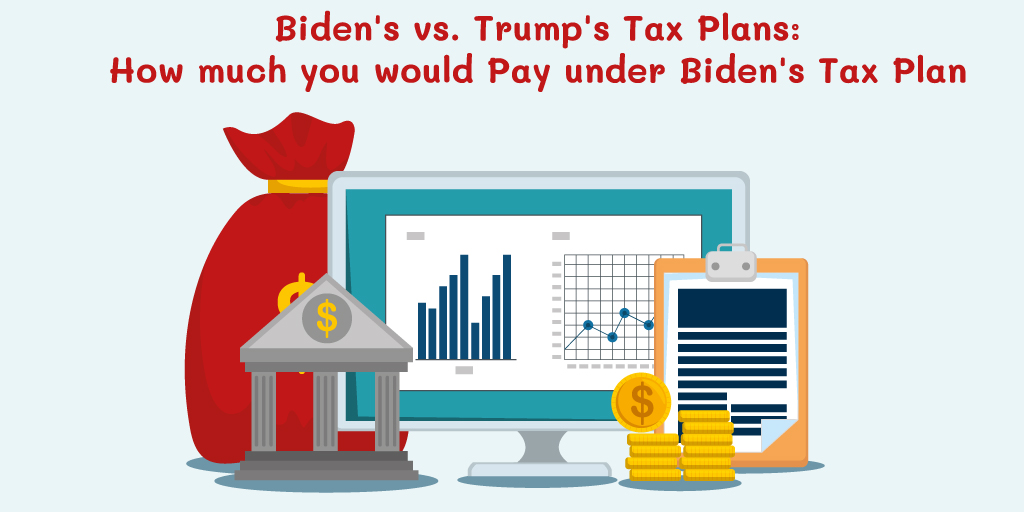Biden’s vs. Trump’s Tax Plans: How much you would Pay under Biden’s Tax Plan
In the last days of the U.S. presidential election, tax policy played a key role. Through the tax code, so many things are attempted, partially accomplished, or fully accomplished. This year, Biden and Trump were the main presidential candidates. They both claimed to use the tax code as a tool to rescue the nation out of the deep and prolonged economic collapse.
However, it is not a surprise that their ideas are different. The former VP Joe Biden tax plan was to increase taxes for the top 1% Individual earners and corporations. The plan also offers several well-outlined tax breaks for moderate and lower-income families. The aim is to ease the financial difficulties resulting from the pandemic and encourage spending to assist restore the economy.
On the contrary, President Donald Trump says that it is devastating to introduce any tax raise to the wealthy. His plan is to retain the lower taxes that were enacted in 2017 in the Tax Cuts and Jobs Act. This will expire at the end of the year 2025. Although he has not released any details, he says he will pass additional cuts.
Here is how the tax policy of each candidate for various groups of the population:
Investors
According to Trump, his plan was to reduce capital-gains taxes. Although he has not provided any details, the reduction of capital gains tax will only favor wealthier folks. The reason, they might have more money in normal taxable brokerage accounts.
Capital-gains taxes do not apply to money kept in individual retirement accounts, such as 401(k)s and tax-deferred plans. In general, investors do not pay income tax on their contributions. Their gains grow tax-free and normal income-tax rates apply to money withdrawn.
Under Biden’s tax plan, the ordinary income-tax rates of up to 39.6% would be taxed on investment profits exceeding $1 million. This means the current and highest 20% tax rate on capital gains will not apply/MUST increase. On the other hand, the current long-term rate will apply for gains less than $ 1 million if the investment has been held for over a year.
In short, Biden’s tax plan retains the capital-gains tax rate for 99% of bottom earners. There is no capital-gains tax for married couples with a taxable income of less than $80,000. However, a 15% tax rate will apply to gains if the taxable Income is over $80,000 but less than $496,600. Likewise, a 20% tax rate will apply for couples with a taxable income of between $496,600 and $1 million.

Middle-Income Earners
The initial tax plan of Joe Biden was released in April. However, he later updated it to ensure it addresses the financial hardships experienced this year due to the Covid pandemic. Indeed, he had a long list of proposals about new and improved tax credits. Some of these include:
- A $5,000 credit for all informal caregivers.
- Childless workers over the age of 65 years are eligible for the Earned Income Tax Credit. At the moment, these taxpayers are ineligible for this credit.
- First-time home buyers will get a $15,000 credit and a credit to make sure their rent and utility bill is not more than 30% of monthly Income.
- Increasing the value of the child and dependent tax credit. Increase from the current maximum non-refundable $2,100 for not less than two children to a refundable maximum of $8,000.
- Start a temporary raise in the child tax credit until the economy recovers. The current child tax credit is non-refundable $2,000 per child of up to 16 years. The plan is to increase it to a refundable $3,600 per child up to 6 years and $3,000 per child up to 17years. In a refundable credit, you are paid as a refund, even if you do not owe taxes.
According to Garrett Watson, a nonpartisan senior policy analyst at the Tax Foundation, Biden’s tax plan does not intend to increase tax for people earning less than $400,000. However, he says the plan is still a work in progress.
Trump’s plan is to extend the current tax law. Although he has not disclosed the specifics of his plan, Trump says he wants to cut taxes for the middle-class folks. In addition, he has vowed to push for the implementation of permanent cuts to the payroll tax. This tax funds Medicare and Social Security.
Back in August, President Trump issued an executive memorandum to let employers defer payroll taxes for any person earning below $4,000 biweekly until the end of 2020. Nevertheless, only a few employers and companies took advantage of this temporary measure. They cite administrative complications. An analysis from the Tax Foundation suggests that Biden’s tax plan will raise after-tax Income for 20% bottom earners by 10.8% up to 2025. As per TCJA, the 20% bottom earners might receive a 1% increase In after-tax Income, and an increase of 1% to 1.5% in the next quintile.
Top Earners
President Trump’s plan is in favor of top earners. He is planning to extend the provisions of the TCJA beyond their set expiration date. For top earners, he want to retain your 37% top tax rate, while pass-through owners will continue to enjoy the 20% deduction. According to The Tax Foundation’s analysis, Trump’s plan to maintain the TCJA will increase the after-tax Income by 2.4% for the top 20% of earners. On the other hand, Biden’s tax plan will decrease the annual after-tax Income of the top1% of earners by 11.3%. The after-tax Income of the other 4% of top earners will decrease by 1.3%.
Biden is planning to increase the top marginal Individual Income-tax rate from 37% to 39.6%. Before the implementation of the TCJA in 2018, 37% was the highest rate. Biden will then accelerate the expiration of this 37% rate. This tax-rate applies to the Taxable Income of over $622,050 for married couples and $518,400 for individuals. The other tax brackets will remain at their present levels of 10%,12%,22%,24%,32%,and 35% of taxable income.

Furthermore, the top earners will incur a new Social Security tax. When this tax combines with the Medicare tax, it is known as the payroll tax. Currently, the 12.4% Social Security tax applies to an income of up to $137,700. The salaried employees split this tax with their employers to pay 6.2% each. In such a case, the employer deducts the employees’ share from their paychecks. On the contrary, self-employed workers pay their full amount.
- Under Biden’s plan, the payroll tax will also apply to an income of over $400,000. This will create a hole in the policy, as the levy will not apply to incomes from $137,700 to $400,000.
- Biden will also use different ways to trim deductions for people earning an income of over $400,000. His plan is imposing a 28% cap on the value of all itemized deductions. Therefore, each deductible dollar in the top tax bracket will reduce by 28%, rather than 39.6%.
- The plan is also reinstating a phase-out of deductions for top earners known as the Pease Limitation. This reduces deductions on each dollar by three cents.
Benefactors and Heirs
Biden’s tax plan aims to increase tax for the wealthy and decrease taxes for people who earn below $400,000 per year and those who incur less in capital gains. The basis of most of his proposals is to repeal the TCJA, and then work from that point.
This also applies to his approach on the estate tax. However, his approach to passing on assets after death is controversial and less detailed.
TCJA doubled the per person estate-tax exemption of $ 5.49 and later adjusted for inflation. This means at the moment. You will not incur the estate tax when you leave an estate worth up to $11.58million. For couples, this figure is $23.16million each couple. Biden plans to return the exemption at $3.5million per person, as it was in 2009. He however, will increase the estate tax rate from 40% to 45%.
The estate itself pays the estate tax before the division of assets to their respective heirs. In short, heirs of any inherited property do not owe any tax even if they instantly sell the property. Biden also plans to eliminate the step-up in cost basis at death. In the current law, an asset’s purchase price or cost basis gets reset to the current market value if the owner dies. If heirs inherit an asset with many attached capital gains, the capital-gains resets to zero when the owner dies. This means they only owe taxes after appreciation of the reset.
Biden’s plan to change this has raised many confusions and concerns, as most claim it is double taxation. Others claim this change is ideal to ensure people change their way of managing portfolios.
Summary
Now that Joe Biden is the president-elect, the new tax rules will be enacted in 2022 after making the ideal adjustments.
For more information about UBOS, you can refer to our website https://ubos.pro/ or contact us at https://ubos.pro/contact/ and get help with filing taxes.


Your Comment
Leave a Reply Now